
KAG
KAG is a logical form-guided reasoning and retrieval framework based on OpenSPG engine and LLMs. It is used to build logical reasoning and factual Q&A solutions for professional domain knowledge bases. It can effectively overcome the shortcomings of the traditional RAG vector similarity calculation model.
Stars: 6248
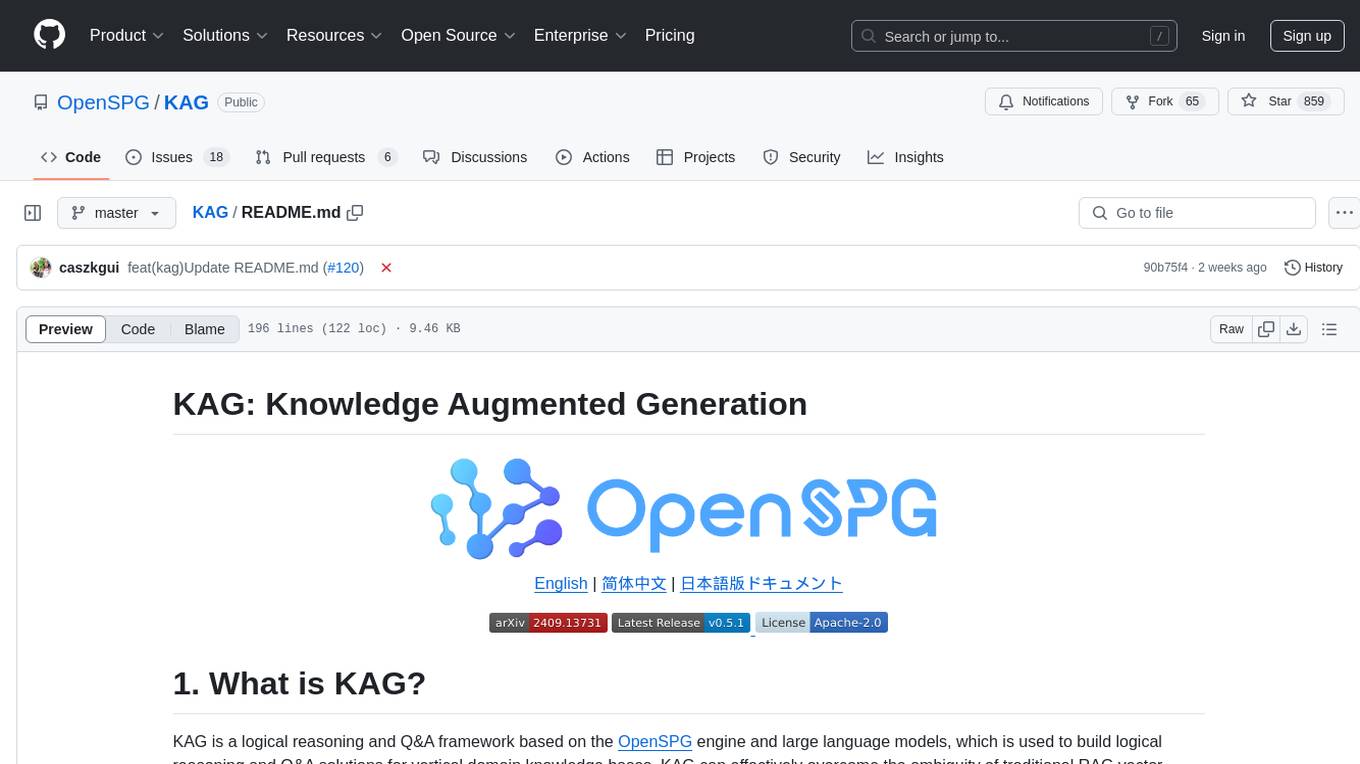
KAG is a logical reasoning and Q&A framework based on the OpenSPG engine and large language models. It is used to build logical reasoning and Q&A solutions for vertical domain knowledge bases. KAG supports logical reasoning, multi-hop fact Q&A, and integrates knowledge and chunk mutual indexing structure, conceptual semantic reasoning, schema-constrained knowledge construction, and logical form-guided hybrid reasoning and retrieval. The framework includes kg-builder for knowledge representation and kg-solver for logical symbol-guided hybrid solving and reasoning engine. KAG aims to enhance LLM service framework in professional domains by integrating logical and factual characteristics of KGs.
README:
English | 简体中文 | 日本語版ドキュメント
KAG is a logical reasoning and Q&A framework based on the OpenSPG engine and large language models, which is used to build logical reasoning and Q&A solutions for vertical domain knowledge bases. KAG can effectively overcome the ambiguity of traditional RAG vector similarity calculation and the noise problem of GraphRAG introduced by OpenIE. KAG supports logical reasoning and multi-hop fact Q&A, etc., and is significantly better than the current SOTA method.
The goal of KAG is to build a knowledge-enhanced LLM service framework in professional domains, supporting logical reasoning, factual Q&A, etc. KAG fully integrates the logical and factual characteristics of the KGs. Its core features include:
- Knowledge and Chunk Mutual Indexing structure to integrate more complete contextual text information
- Knowledge alignment using conceptual semantic reasoning to alleviate the noise problem caused by OpenIE
- Schema-constrained knowledge construction to support the representation and construction of domain expert knowledge
- Logical form-guided hybrid reasoning and retrieval to support logical reasoning and multi-hop reasoning Q&A
⭐️ Star our repository to stay up-to-date with exciting new features and improvements! Get instant notifications for new releases! 🌟
In the context of private knowledge bases, unstructured data, structured information, and business expert experience often coexist. KAG references the DIKW hierarchy to upgrade SPG to a version that is friendly to LLMs.
For unstructured data such as news, events, logs, and books, as well as structured data like transactions, statistics, and approvals, along with business experience and domain knowledge rules, KAG employs techniques such as layout analysis, knowledge extraction, property normalization, and semantic alignment to integrate raw business data and expert rules into a unified business knowledge graph.
This makes it compatible with schema-free information extraction and schema-constrained expertise construction on the same knowledge type (e. G., entity type, event type), and supports the cross-index representation between the graph structure and the original text block.
This mutual index representation is helpful to the construction of inverted index based on graph structure, and promotes the unified representation and reasoning of logical forms.
KAG proposes a logically formal guided hybrid solution and inference engine.
The engine includes three types of operators: planning, reasoning, and retrieval, which transform natural language problems into problem solving processes that combine language and notation.
In this process, each step can use different operators, such as exact match retrieval, text retrieval, numerical calculation or semantic reasoning, so as to realize the integration of four different problem solving processes: Retrieval, Knowledge Graph reasoning, language reasoning and numerical calculation.
- 2025.01.07 : Support domain knowledge injection, domain schema customization, QFS tasks support, Visual query analysis, enables schema-constraint mode for extraction, etc.
- 2024.11.21 : Support Word docs upload, model invoke concurrency setting, User experience optimization, etc.
- 2024.10.25 : KAG initial release
- Logical reasoning optimization, conversational tasks support
- kag-model release, kag solution for event reasoning knowledge graph and medical knowledge graph
- kag front-end open source, distributed build support, mathematical reasoning optimization
-
Recommend System Version:
macOS User:macOS Monterey 12.6 or later Linux User:CentOS 7 / Ubuntu 20.04 or later Windows User:Windows 10 LTSC 2021 or later -
Software Requirements:
macOS / Linux User:Docker,Docker Compose Windows User:WSL 2 / Hyper-V,Docker,Docker Compose
Use the following commands to download the docker-compose.yml file and launch the services with Docker Compose.
# set the HOME environment variable (only Windows users need to execute this command)
# set HOME=%USERPROFILE%
curl -sSL https://raw.githubusercontent.com/OpenSPG/openspg/refs/heads/master/dev/release/docker-compose-west.yml -o docker-compose-west.yml
docker compose -f docker-compose-west.yml up -dNavigate to the default url of the KAG product with your browser: http://127.0.0.1:8887
Default Username: openspg
Default password: openspg@kag
See KAG usage (product mode) for detailed introduction.
Refer to the 3.1 section to complete the installation of the engine & dependent image.
macOS / Linux developers
# Create conda env: conda create -n kag-demo python=3.10 && conda activate kag-demo
# Clone code: git clone https://github.com/OpenSPG/KAG.git
# Install KAG: cd KAG && pip install -e .
Windows developers
# Install the official Python 3.8.10 or later, install Git.
# Create and activate Python venv: py -m venv kag-demo && kag-demo\Scripts\activate
# Clone code: git clone https://github.com/OpenSPG/KAG.git
# Install KAG: cd KAG && pip install -e .
Please refer to KAG usage (developer mode) guide for detailed introduction of the toolkit. Then you can use the built-in components to reproduce the performance results of the built-in datasets, and apply those components to new busineness scenarios.
The KAG framework includes three parts: kg-builder, kg-solver, and kag-model. This release only involves the first two parts, kag-model will be gradually open source release in the future.
kg-builder implements a knowledge representation that is friendly to large-scale language models (LLM). Based on the hierarchical structure of DIKW (data, information, knowledge and wisdom), IT upgrades SPG knowledge representation ability, and is compatible with information extraction without schema constraints and professional knowledge construction with schema constraints on the same knowledge type (such as entity type and event type), it also supports the mutual index representation between the graph structure and the original text block, which supports the efficient retrieval of the reasoning question and answer stage.
kg-solver uses a logical symbol-guided hybrid solving and reasoning engine that includes three types of operators: planning, reasoning, and retrieval, to transform natural language problems into a problem-solving process that combines language and symbols. In this process, each step can use different operators, such as exact match retrieval, text retrieval, numerical calculation or semantic reasoning, so as to realize the integration of four different problem solving processes: Retrieval, Knowledge Graph reasoning, language reasoning and numerical calculation.
GitHub: https://github.com/OpenSPG/KAG
Website: https://spg.openkg.cn/
Join our Discord community.
Follow OpenSPG Official Account to get technical articles and product updates about OpenSPG and KAG.
Scan the QR code below to join our WeChat group.
KAG introduction and applications: https://github.com/orgs/OpenSPG/discussions/52
If you use this software, please cite it as below:
-
KAG: Boosting LLMs in Professional Domains via Knowledge Augmented Generation
-
KGFabric: A Scalable Knowledge Graph Warehouse for Enterprise Data Interconnection
@article{liang2024kag,
title={KAG: Boosting LLMs in Professional Domains via Knowledge Augmented Generation},
author={Liang, Lei and Sun, Mengshu and Gui, Zhengke and Zhu, Zhongshu and Jiang, Zhouyu and Zhong, Ling and Zhao, Peilong and Bo, Zhongpu and Yang, Jin and others},
journal={arXiv preprint arXiv:2409.13731},
year={2024}
}
@article{yikgfabric,
title={KGFabric: A Scalable Knowledge Graph Warehouse for Enterprise Data Interconnection},
author={Yi, Peng and Liang, Lei and Da Zhang, Yong Chen and Zhu, Jinye and Liu, Xiangyu and Tang, Kun and Chen, Jialin and Lin, Hao and Qiu, Leijie and Zhou, Jun}
}Lei Liang, Mengshu Sun, Zhengke Gui, Zhongshu Zhu, Zhouyu Jiang, Ling Zhong, Peilong Zhao, Zhongpu Bo, Jin Yang, Huaidong Xiong, Lin Yuan, Jun Xu, Zaoyang Wang, Zhiqiang Zhang, Wen Zhang, Huajun Chen, Wenguang Chen, Jun Zhou, Haofen Wang
For Tasks:
Click tags to check more tools for each tasksFor Jobs:
Alternative AI tools for KAG
Similar Open Source Tools

KAG
KAG is a logical reasoning and Q&A framework based on the OpenSPG engine and large language models. It is used to build logical reasoning and Q&A solutions for vertical domain knowledge bases. KAG supports logical reasoning, multi-hop fact Q&A, and integrates knowledge and chunk mutual indexing structure, conceptual semantic reasoning, schema-constrained knowledge construction, and logical form-guided hybrid reasoning and retrieval. The framework includes kg-builder for knowledge representation and kg-solver for logical symbol-guided hybrid solving and reasoning engine. KAG aims to enhance LLM service framework in professional domains by integrating logical and factual characteristics of KGs.
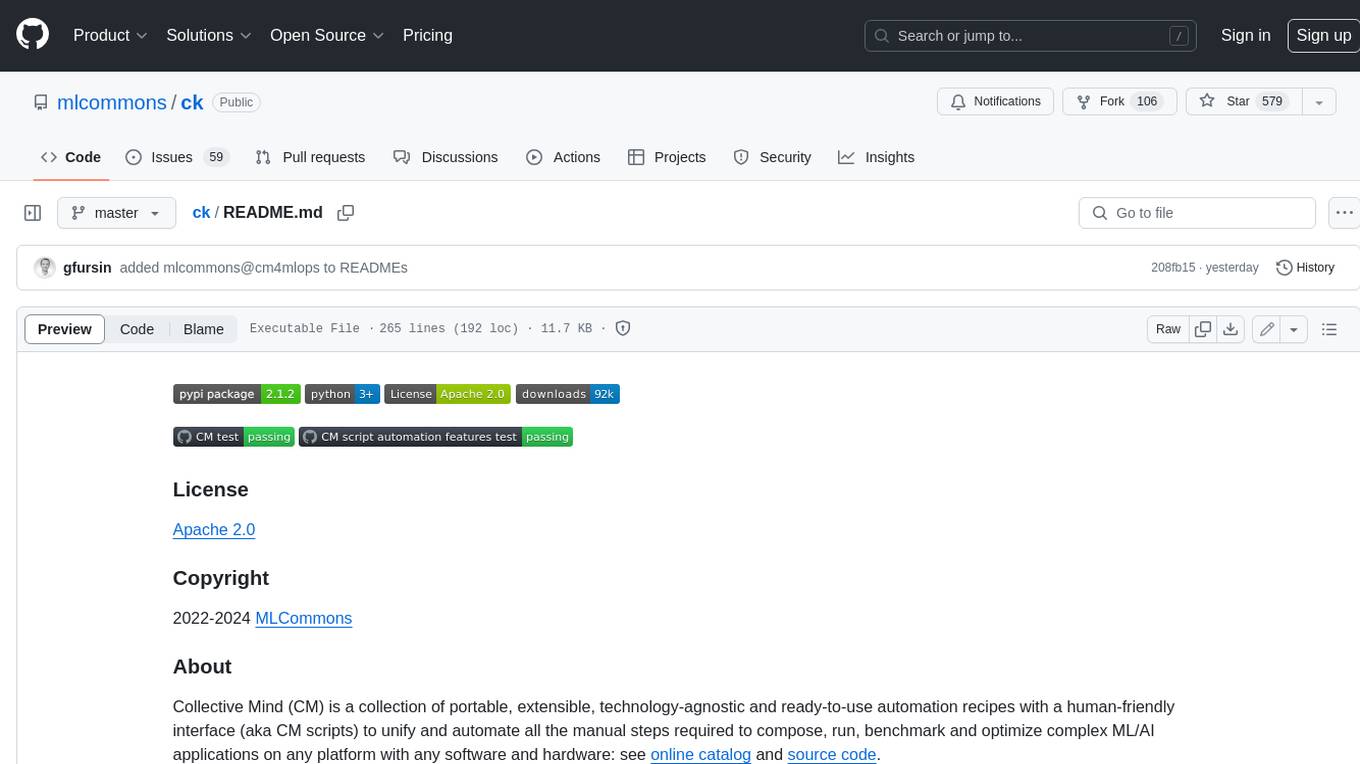
ck
Collective Mind (CM) is a collection of portable, extensible, technology-agnostic and ready-to-use automation recipes with a human-friendly interface (aka CM scripts) to unify and automate all the manual steps required to compose, run, benchmark and optimize complex ML/AI applications on any platform with any software and hardware: see online catalog and source code. CM scripts require Python 3.7+ with minimal dependencies and are continuously extended by the community and MLCommons members to run natively on Ubuntu, MacOS, Windows, RHEL, Debian, Amazon Linux and any other operating system, in a cloud or inside automatically generated containers while keeping backward compatibility - please don't hesitate to report encountered issues here and contact us via public Discord Server to help this collaborative engineering effort! CM scripts were originally developed based on the following requirements from the MLCommons members to help them automatically compose and optimize complex MLPerf benchmarks, applications and systems across diverse and continuously changing models, data sets, software and hardware from Nvidia, Intel, AMD, Google, Qualcomm, Amazon and other vendors: * must work out of the box with the default options and without the need to edit some paths, environment variables and configuration files; * must be non-intrusive, easy to debug and must reuse existing user scripts and automation tools (such as cmake, make, ML workflows, python poetry and containers) rather than substituting them; * must have a very simple and human-friendly command line with a Python API and minimal dependencies; * must require minimal or zero learning curve by using plain Python, native scripts, environment variables and simple JSON/YAML descriptions instead of inventing new workflow languages; * must have the same interface to run all automations natively, in a cloud or inside containers. CM scripts were successfully validated by MLCommons to modularize MLPerf inference benchmarks and help the community automate more than 95% of all performance and power submissions in the v3.1 round across more than 120 system configurations (models, frameworks, hardware) while reducing development and maintenance costs.
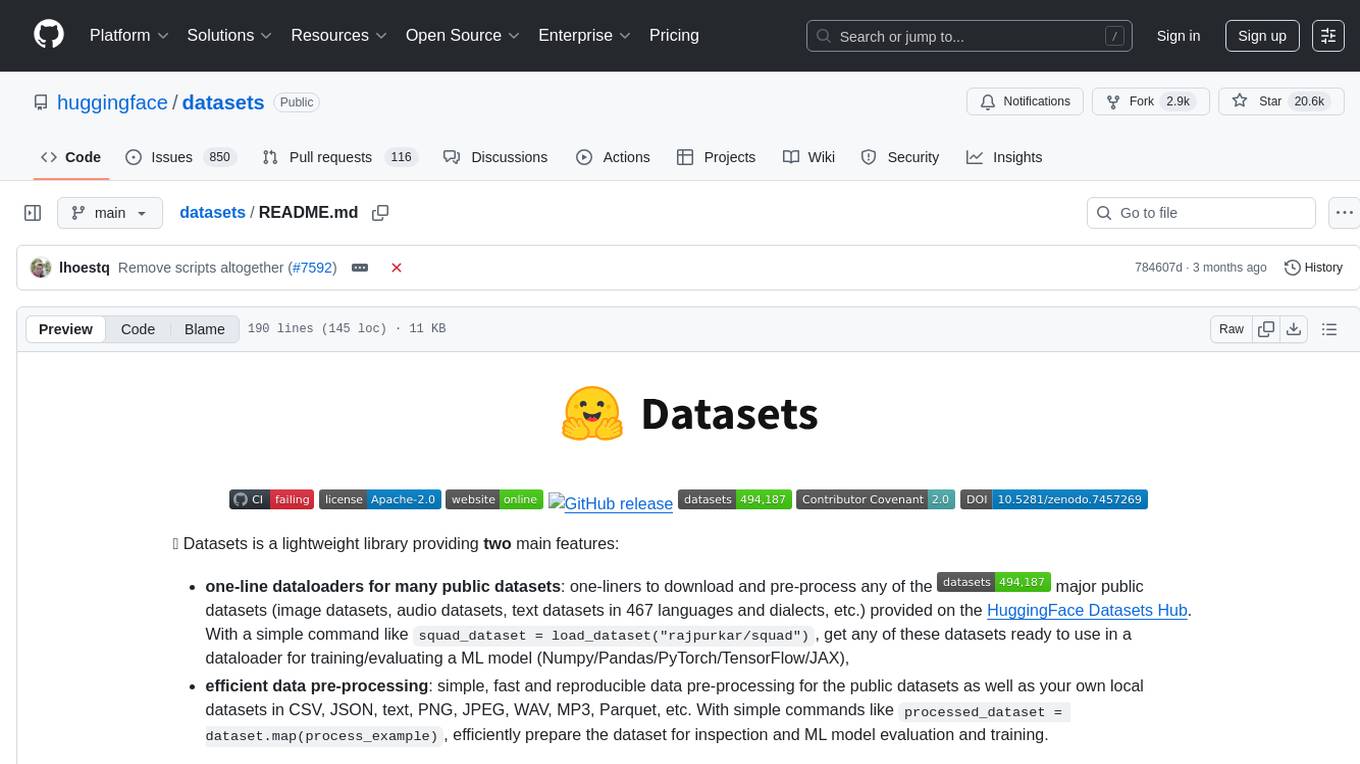
datasets
Datasets is a repository that provides a collection of various datasets for machine learning and data analysis projects. It includes datasets in different formats such as CSV, JSON, and Excel, covering a wide range of topics including finance, healthcare, marketing, and more. The repository aims to help data scientists, researchers, and students access high-quality datasets for training models, conducting experiments, and exploring data analysis techniques.
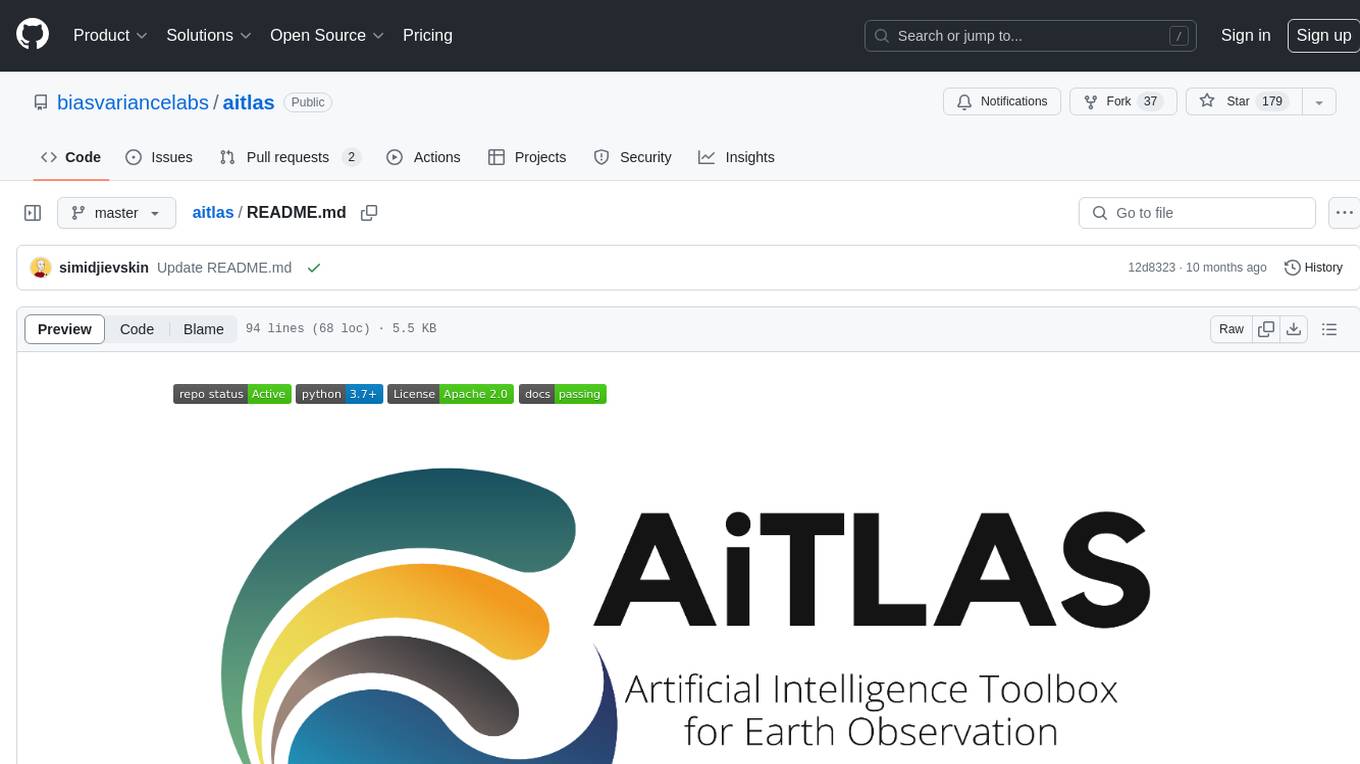
aitlas
The AiTLAS toolbox (Artificial Intelligence Toolbox for Earth Observation) includes state-of-the-art machine learning methods for exploratory and predictive analysis of satellite imagery as well as a repository of AI-ready Earth Observation (EO) datasets. It can be easily applied for a variety of Earth Observation tasks, such as land use and cover classification, crop type prediction, localization of specific objects (semantic segmentation), etc. The main goal of AiTLAS is to facilitate better usability and adoption of novel AI methods (and models) by EO experts, while offering easy access and standardized format of EO datasets to AI experts which allows benchmarking of various existing and novel AI methods tailored for EO data.
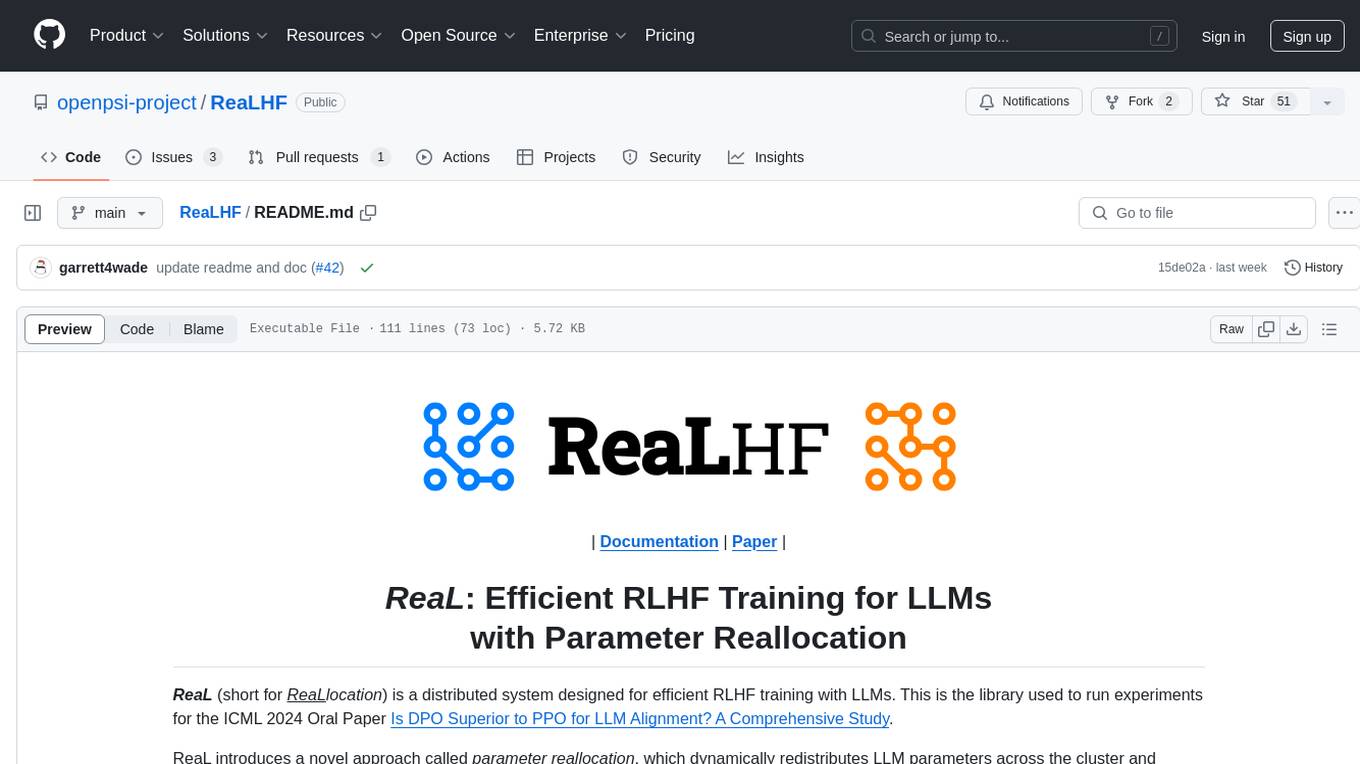
ReaLHF
ReaLHF is a distributed system designed for efficient RLHF training with Large Language Models (LLMs). It introduces a novel approach called parameter reallocation to dynamically redistribute LLM parameters across the cluster, optimizing allocations and parallelism for each computation workload. ReaL minimizes redundant communication while maximizing GPU utilization, achieving significantly higher Proximal Policy Optimization (PPO) training throughput compared to other systems. It supports large-scale training with various parallelism strategies and enables memory-efficient training with parameter and optimizer offloading. The system seamlessly integrates with HuggingFace checkpoints and inference frameworks, allowing for easy launching of local or distributed experiments. ReaLHF offers flexibility through versatile configuration customization and supports various RLHF algorithms, including DPO, PPO, RAFT, and more, while allowing the addition of custom algorithms for high efficiency.
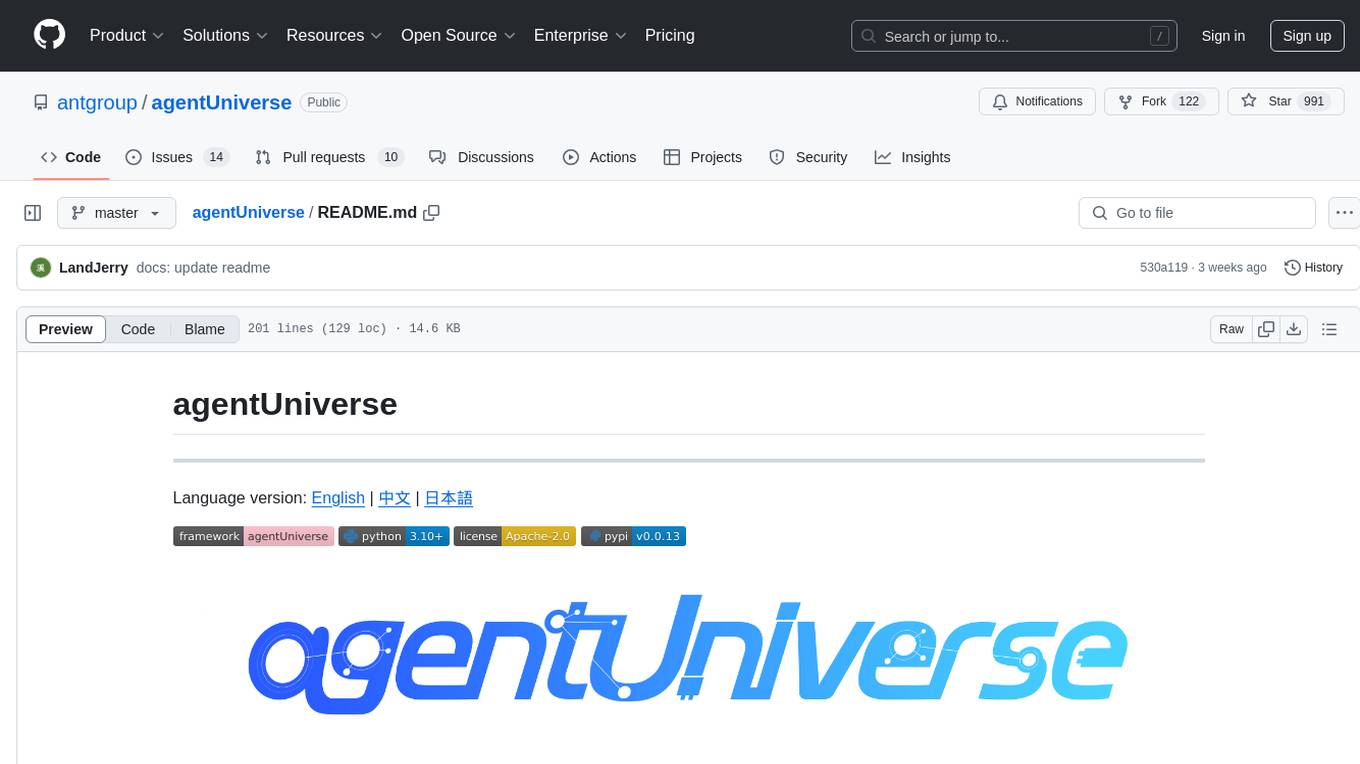
agentUniverse
agentUniverse is a multi-agent framework based on large language models, providing flexible capabilities for building individual agents. It focuses on multi-agent collaborative patterns, integrating domain experience to help agents solve problems in various fields. The framework includes pattern components like PEER and DOE for event interpretation, industry analysis, and financial report generation. It offers features for agent construction, multi-agent collaboration, and domain expertise integration, aiming to create intelligent applications with professional know-how.
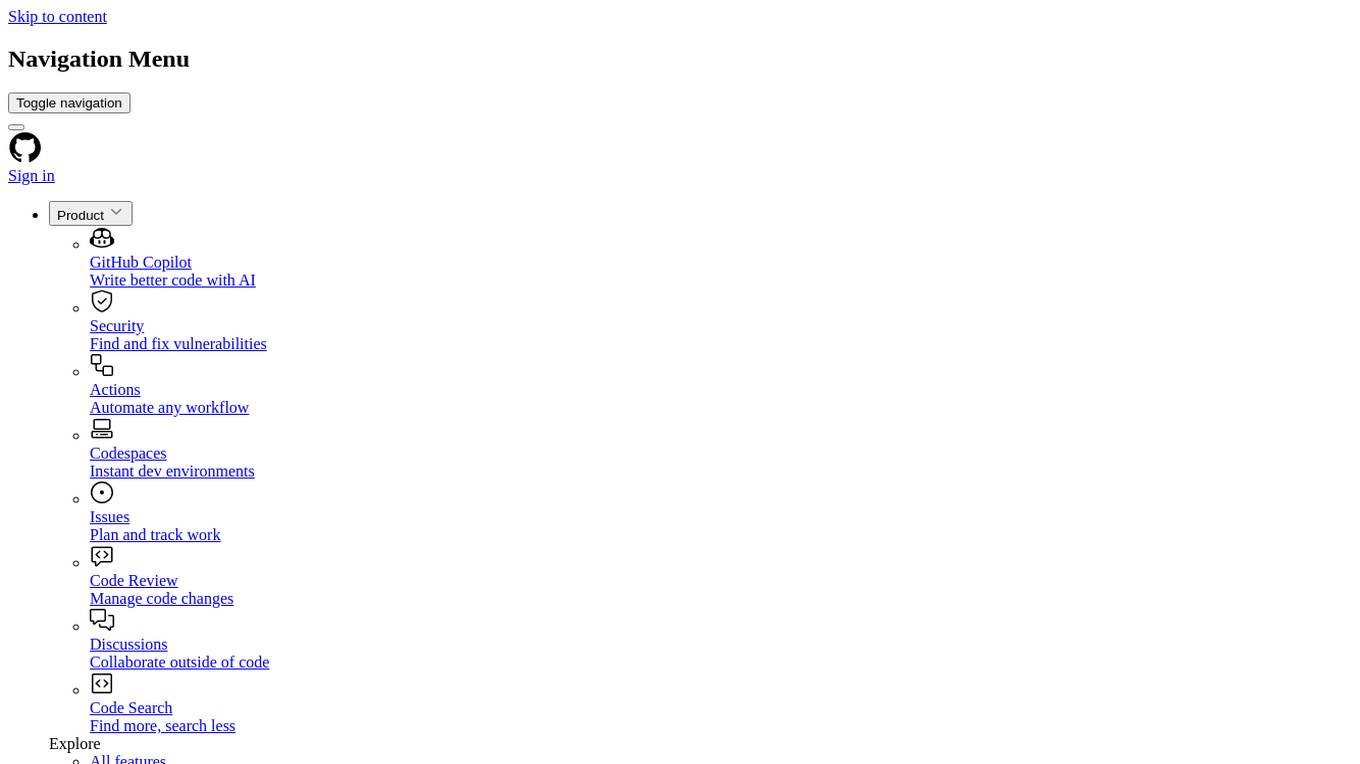
agentUniverse
agentUniverse is a multi-agent framework based on large language models, providing flexible capabilities for building individual agents. It focuses on collaborative pattern components to solve problems in various fields and integrates domain experience. The framework supports LLM model integration and offers various pattern components like PEER and DOE. Users can easily configure models and set up agents for tasks. agentUniverse aims to assist developers and enterprises in constructing domain-expert-level intelligent agents for seamless collaboration.
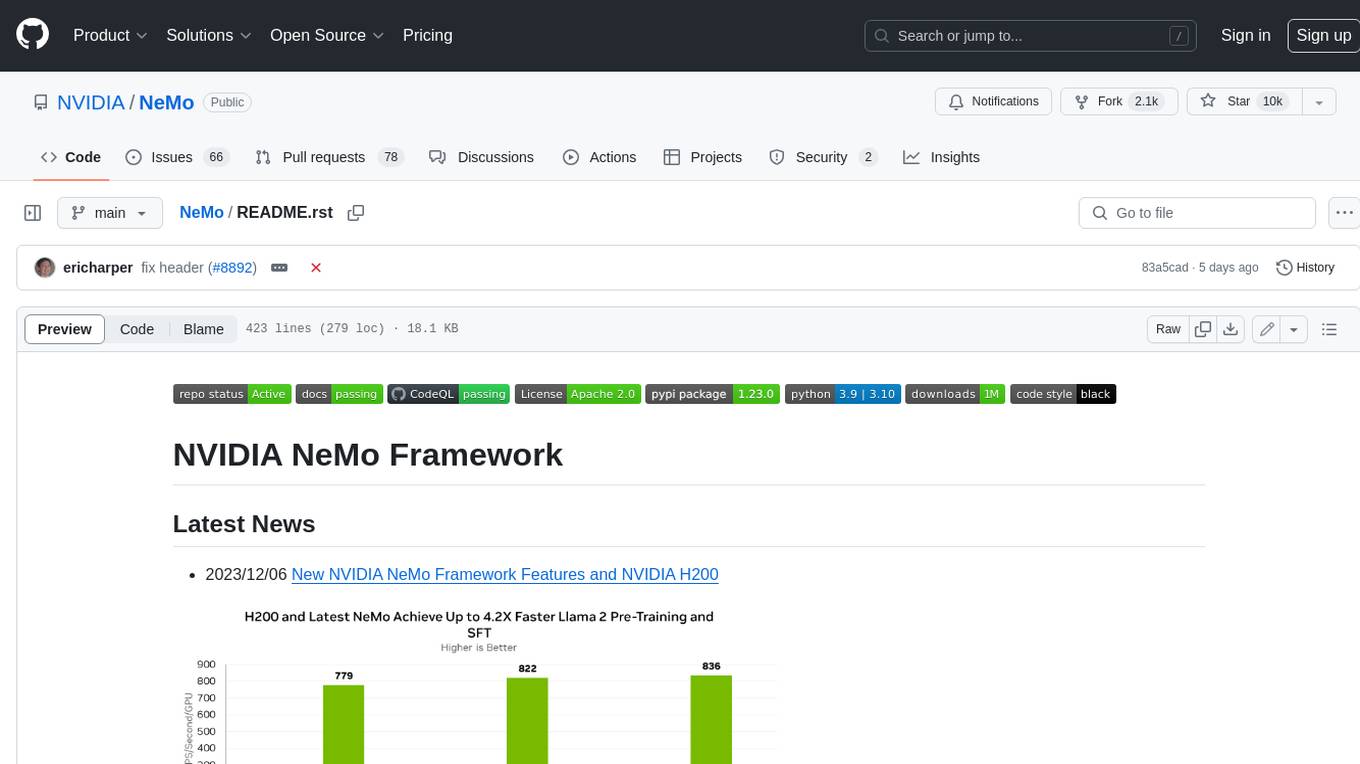
NeMo
NeMo Framework is a generative AI framework built for researchers and pytorch developers working on large language models (LLMs), multimodal models (MM), automatic speech recognition (ASR), and text-to-speech synthesis (TTS). The primary objective of NeMo is to provide a scalable framework for researchers and developers from industry and academia to more easily implement and design new generative AI models by being able to leverage existing code and pretrained models.
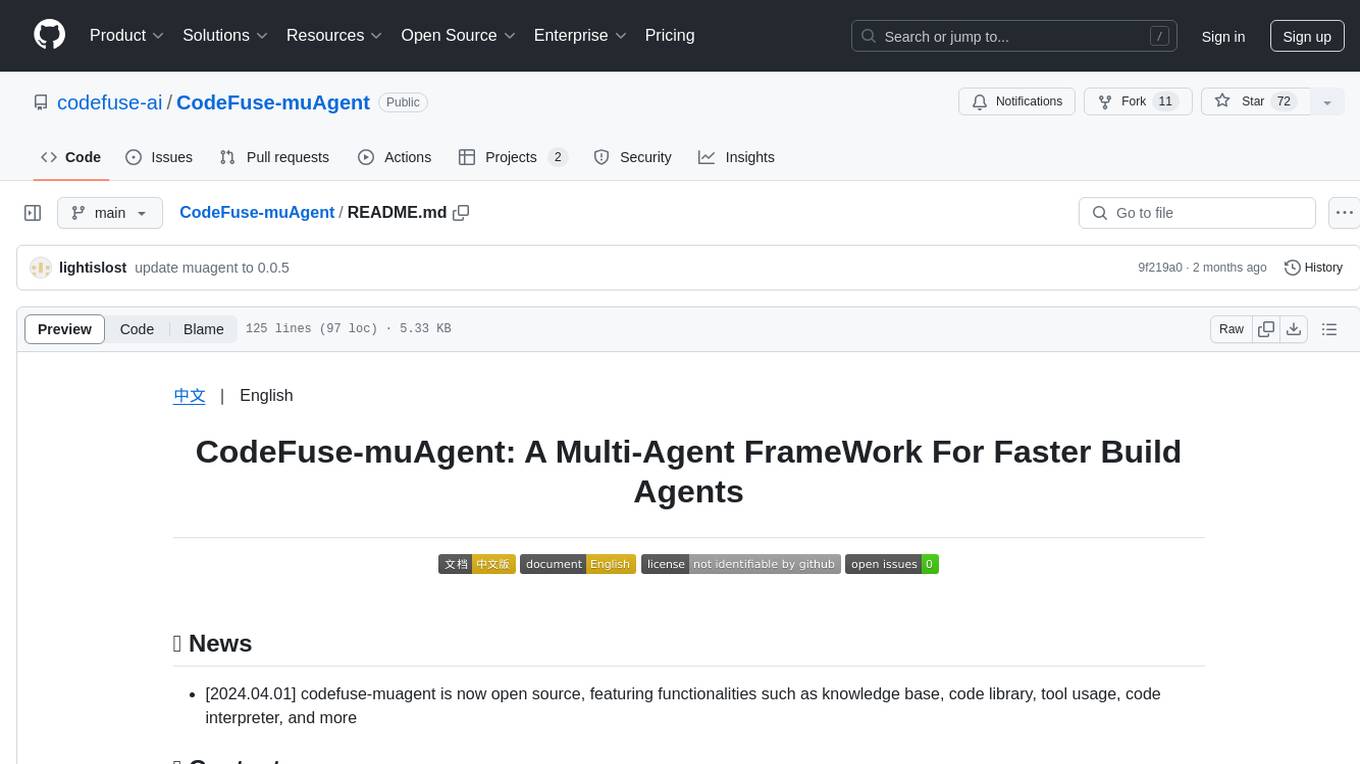
CodeFuse-muAgent
CodeFuse-muAgent is a Multi-Agent framework designed to streamline Standard Operating Procedure (SOP) orchestration for agents. It integrates toolkits, code libraries, knowledge bases, and sandbox environments for rapid construction of complex Multi-Agent interactive applications. The framework enables efficient execution and handling of multi-layered and multi-dimensional tasks.
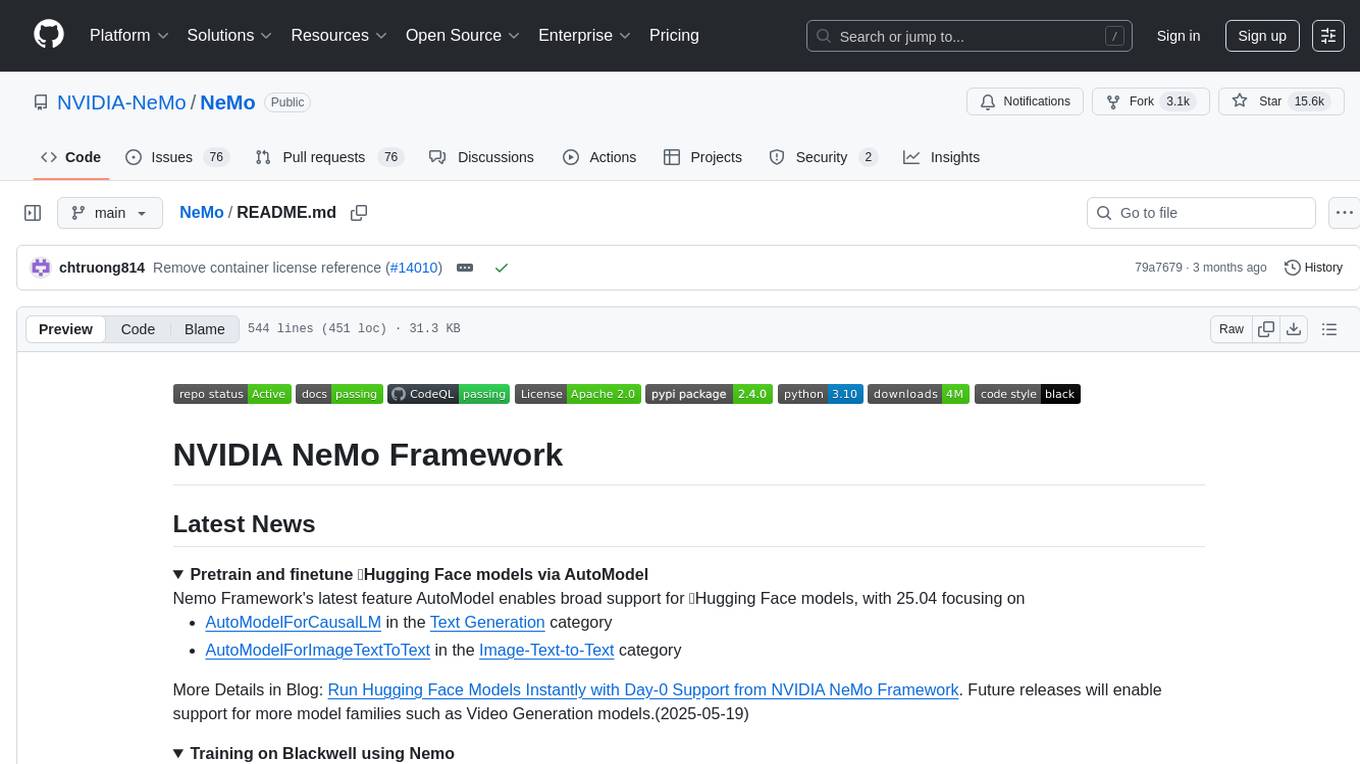
NeMo
NVIDIA NeMo Framework is a scalable and cloud-native generative AI framework built for researchers and PyTorch developers working on Large Language Models (LLMs), Multimodal Models (MMs), Automatic Speech Recognition (ASR), Text to Speech (TTS), and Computer Vision (CV) domains. It is designed to help you efficiently create, customize, and deploy new generative AI models by leveraging existing code and pre-trained model checkpoints.
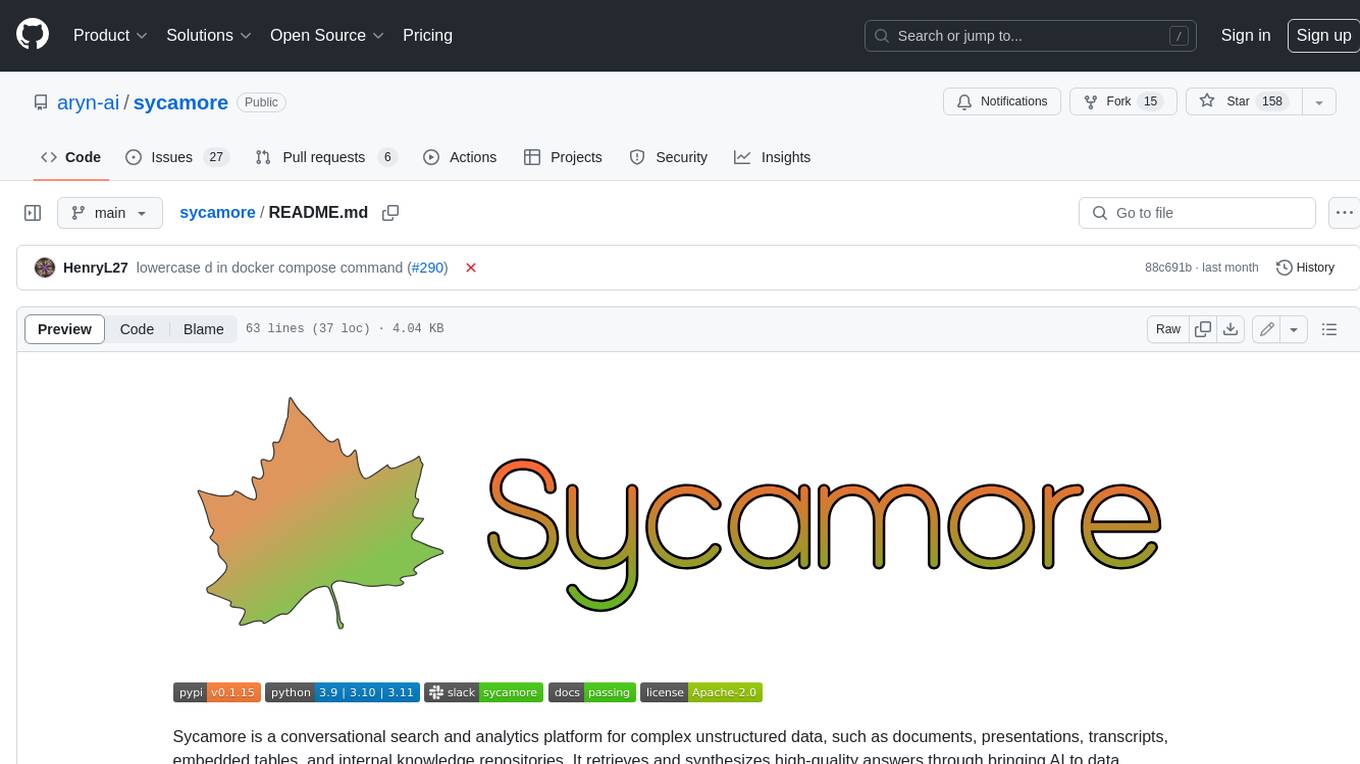
sycamore
Sycamore is a conversational search and analytics platform for complex unstructured data, such as documents, presentations, transcripts, embedded tables, and internal knowledge repositories. It retrieves and synthesizes high-quality answers through bringing AI to data preparation, indexing, and retrieval. Sycamore makes it easy to prepare unstructured data for search and analytics, providing a toolkit for data cleaning, information extraction, enrichment, summarization, and generation of vector embeddings that encapsulate the semantics of data. Sycamore uses your choice of generative AI models to make these operations simple and effective, and it enables quick experimentation and iteration. Additionally, Sycamore uses OpenSearch for indexing, enabling hybrid (vector + keyword) search, retrieval-augmented generation (RAG) pipelining, filtering, analytical functions, conversational memory, and other features to improve information retrieval.
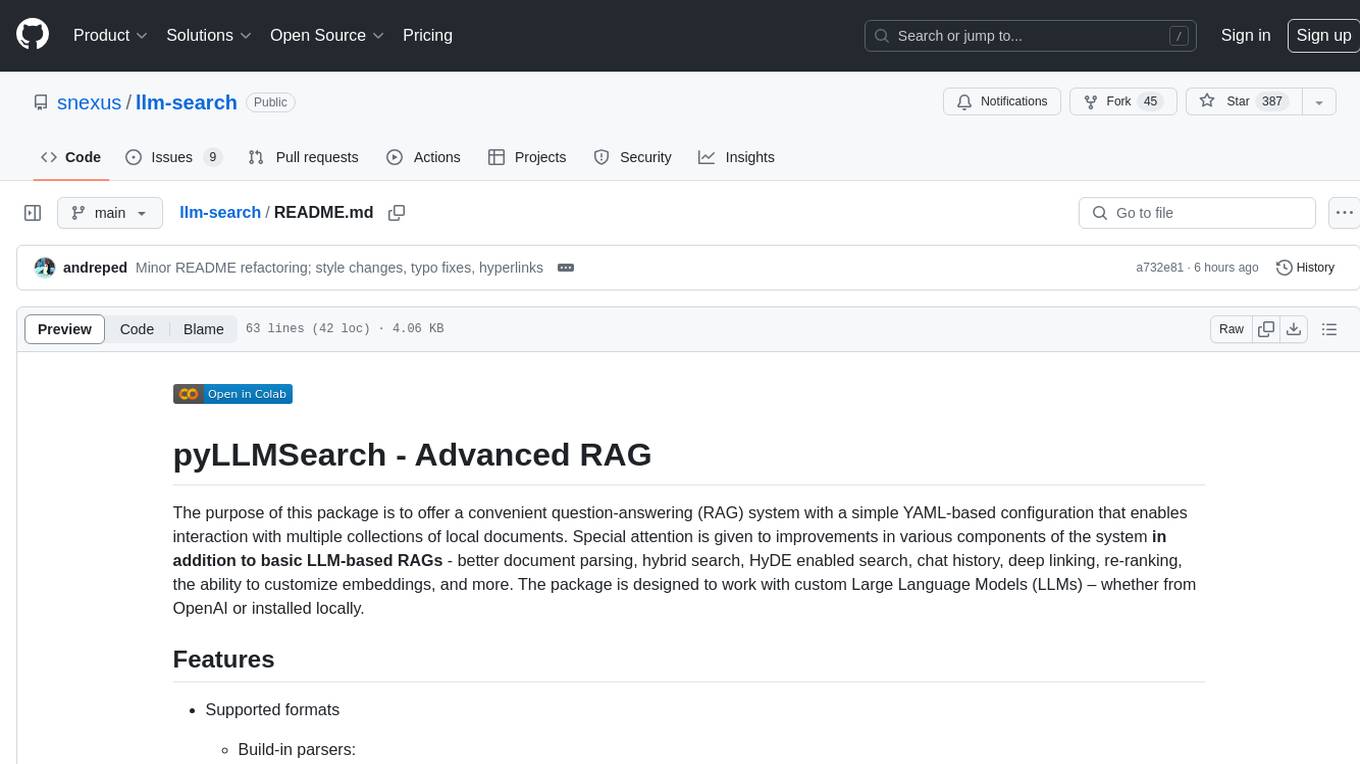
llm-search
pyLLMSearch is an advanced RAG system that offers a convenient question-answering system with a simple YAML-based configuration. It enables interaction with multiple collections of local documents, with improvements in document parsing, hybrid search, chat history, deep linking, re-ranking, customizable embeddings, and more. The package is designed to work with custom Large Language Models (LLMs) from OpenAI or installed locally. It supports various document formats, incremental embedding updates, dense and sparse embeddings, multiple embedding models, 'Retrieve and Re-rank' strategy, HyDE (Hypothetical Document Embeddings), multi-querying, chat history, and interaction with embedded documents using different models. It also offers simple CLI and web interfaces, deep linking, offline response saving, and an experimental API.
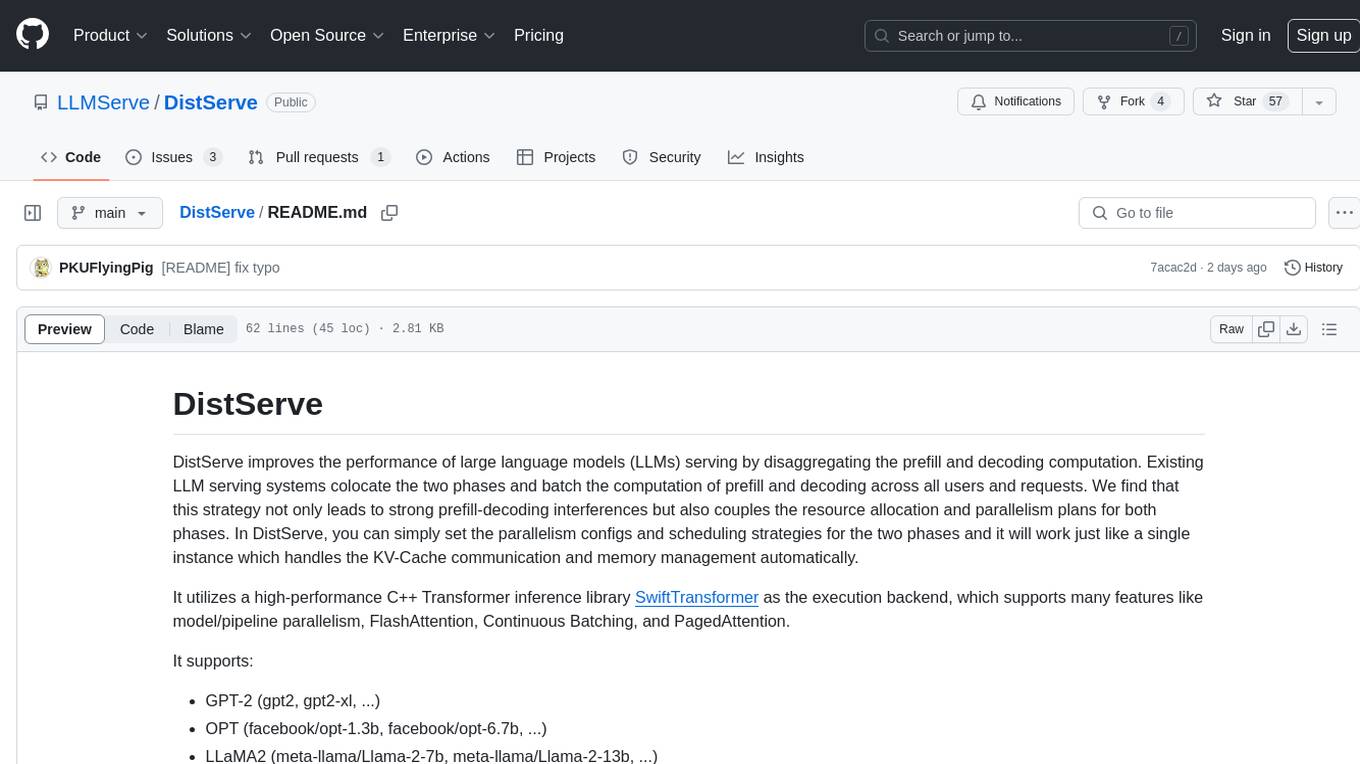
DistServe
DistServe improves the performance of large language models serving by disaggregating the prefill and decoding computation. It allows setting parallelism configs and scheduling strategies for the two phases independently, handling KV-Cache communication and memory management automatically. Utilizes a high-performance C++ Transformer inference library SwiftTransformer with features like model/pipeline parallelism, FlashAttention, Continuous Batching, and PagedAttention. Supports GPT-2, OPT, and LLaMA2 models.
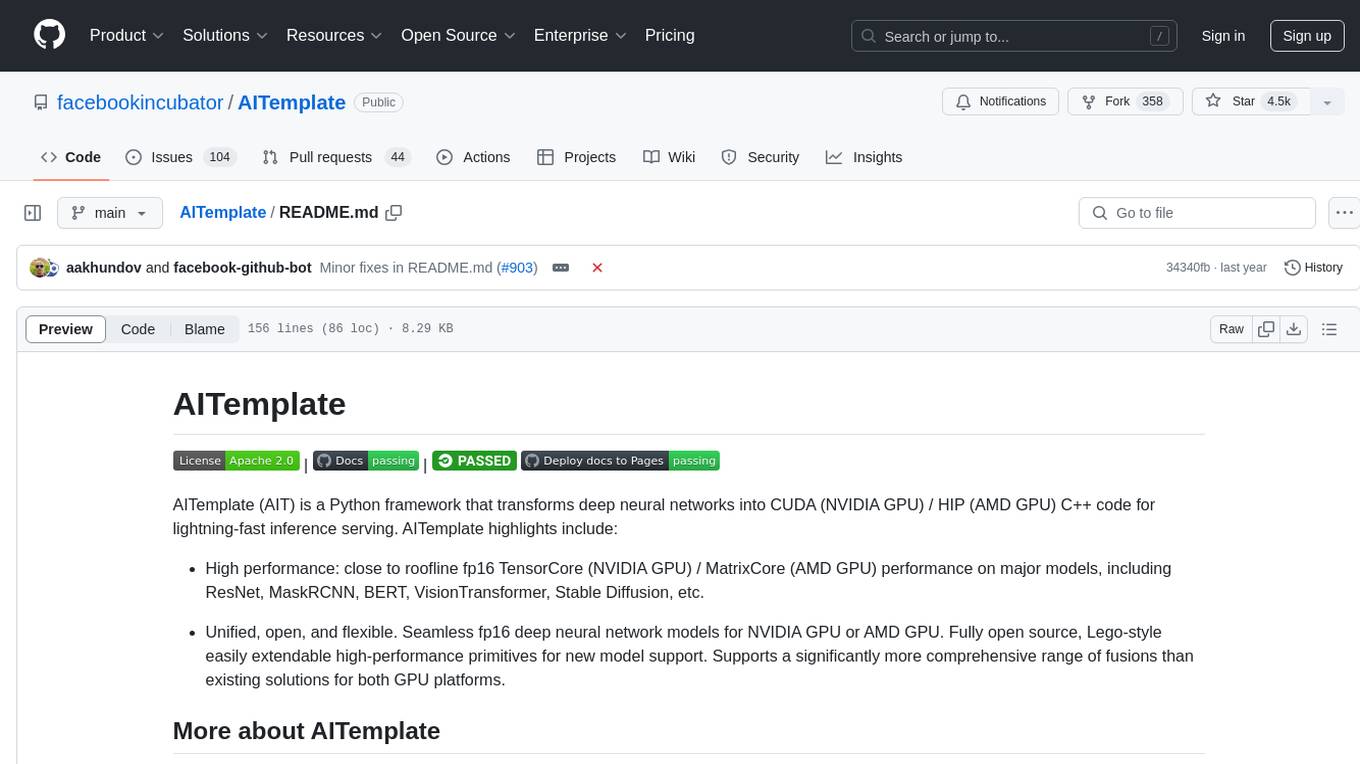
AITemplate
AITemplate (AIT) is a Python framework that transforms deep neural networks into CUDA (NVIDIA GPU) / HIP (AMD GPU) C++ code for lightning-fast inference serving. It offers high performance close to roofline fp16 TensorCore (NVIDIA GPU) / MatrixCore (AMD GPU) performance on major models. AITemplate is unified, open, and flexible, supporting a comprehensive range of fusions for both GPU platforms. It provides excellent backward capability, horizontal fusion, vertical fusion, memory fusion, and works with or without PyTorch. FX2AIT is a tool that converts PyTorch models into AIT for fast inference serving, offering easy conversion and expanded support for models with unsupported operators.

Graph-CoT
This repository contains the source code and datasets for Graph Chain-of-Thought: Augmenting Large Language Models by Reasoning on Graphs accepted to ACL 2024. It proposes a framework called Graph Chain-of-thought (Graph-CoT) to enable Language Models to traverse graphs step-by-step for reasoning, interaction, and execution. The motivation is to alleviate hallucination issues in Language Models by augmenting them with structured knowledge sources represented as graphs.
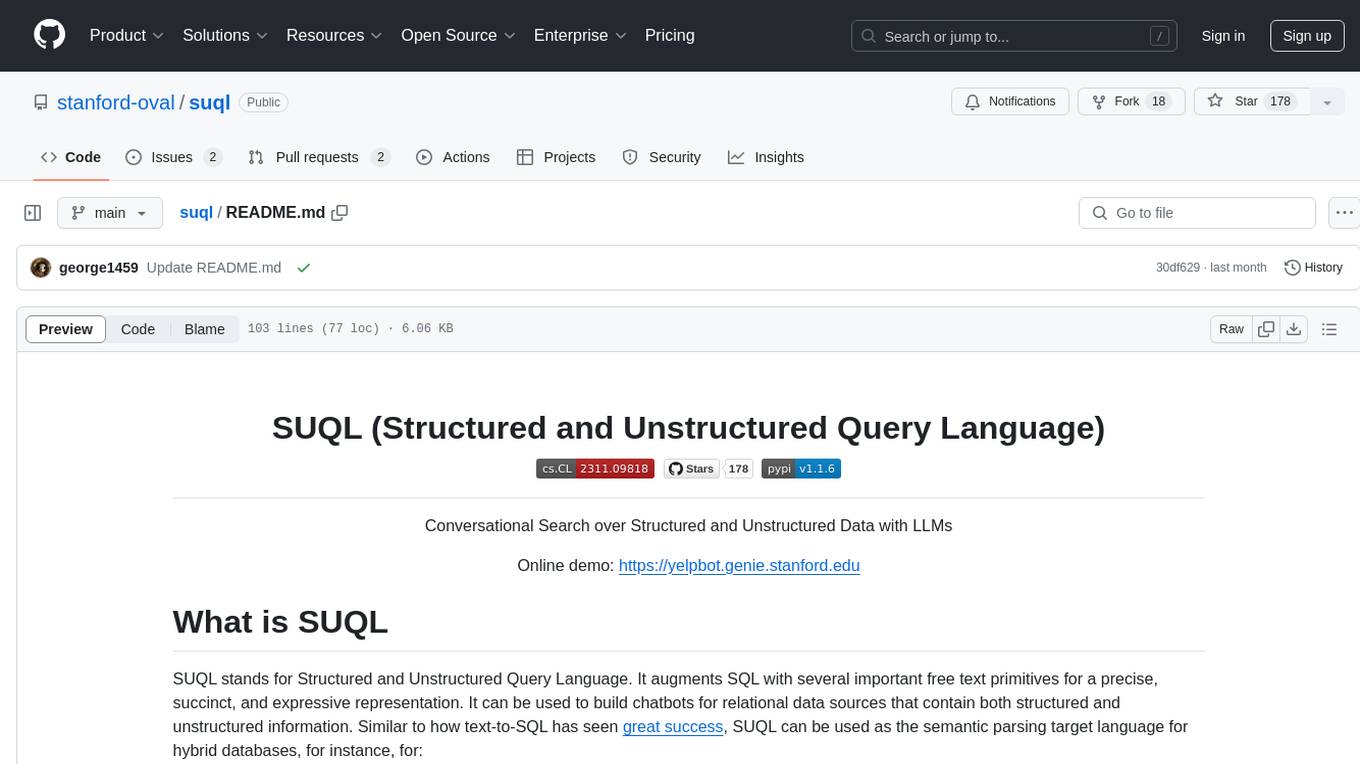
suql
SUQL (Structured and Unstructured Query Language) is a tool that augments SQL with free text primitives for building chatbots that can interact with relational data sources containing both structured and unstructured information. It seamlessly integrates retrieval models, large language models (LLMs), and traditional SQL to provide a clean interface for hybrid data access. SUQL supports optimizations to minimize expensive LLM calls, scalability to large databases with PostgreSQL, and general SQL operations like JOINs and GROUP BYs.
For similar tasks

KAG
KAG is a logical reasoning and Q&A framework based on the OpenSPG engine and large language models. It is used to build logical reasoning and Q&A solutions for vertical domain knowledge bases. KAG supports logical reasoning, multi-hop fact Q&A, and integrates knowledge and chunk mutual indexing structure, conceptual semantic reasoning, schema-constrained knowledge construction, and logical form-guided hybrid reasoning and retrieval. The framework includes kg-builder for knowledge representation and kg-solver for logical symbol-guided hybrid solving and reasoning engine. KAG aims to enhance LLM service framework in professional domains by integrating logical and factual characteristics of KGs.
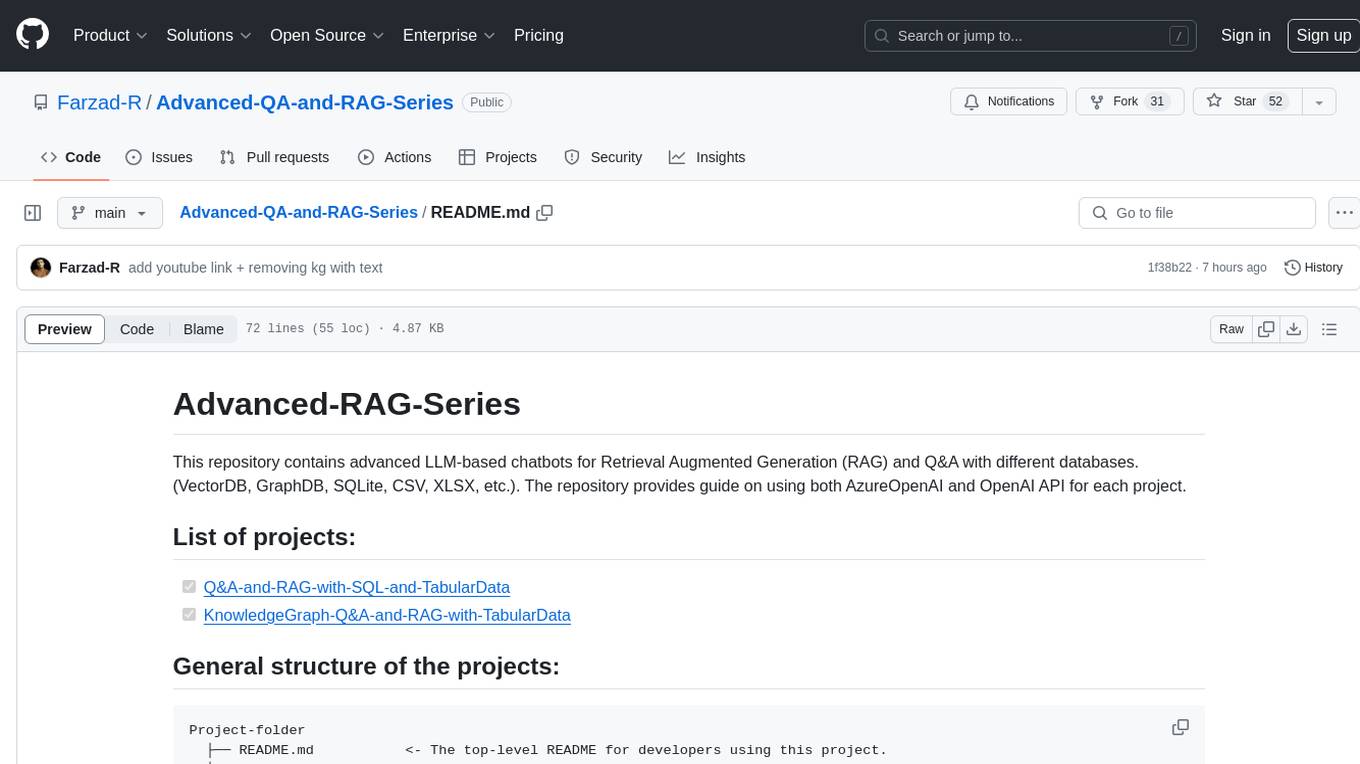
Advanced-QA-and-RAG-Series
This repository contains advanced LLM-based chatbots for Retrieval Augmented Generation (RAG) and Q&A with different databases. It provides guides on using AzureOpenAI and OpenAI API for each project. The projects include Q&A and RAG with SQL and Tabular Data, and KnowledgeGraph Q&A and RAG with Tabular Data. Key notes emphasize the importance of good column names, read-only database access, and familiarity with query languages. The chatbots allow users to interact with SQL databases, CSV, XLSX files, and graph databases using natural language.
For similar jobs

sweep
Sweep is an AI junior developer that turns bugs and feature requests into code changes. It automatically handles developer experience improvements like adding type hints and improving test coverage.

teams-ai
The Teams AI Library is a software development kit (SDK) that helps developers create bots that can interact with Teams and Microsoft 365 applications. It is built on top of the Bot Framework SDK and simplifies the process of developing bots that interact with Teams' artificial intelligence capabilities. The SDK is available for JavaScript/TypeScript, .NET, and Python.

ai-guide
This guide is dedicated to Large Language Models (LLMs) that you can run on your home computer. It assumes your PC is a lower-end, non-gaming setup.

classifai
Supercharge WordPress Content Workflows and Engagement with Artificial Intelligence. Tap into leading cloud-based services like OpenAI, Microsoft Azure AI, Google Gemini and IBM Watson to augment your WordPress-powered websites. Publish content faster while improving SEO performance and increasing audience engagement. ClassifAI integrates Artificial Intelligence and Machine Learning technologies to lighten your workload and eliminate tedious tasks, giving you more time to create original content that matters.

chatbot-ui
Chatbot UI is an open-source AI chat app that allows users to create and deploy their own AI chatbots. It is easy to use and can be customized to fit any need. Chatbot UI is perfect for businesses, developers, and anyone who wants to create a chatbot.

BricksLLM
BricksLLM is a cloud native AI gateway written in Go. Currently, it provides native support for OpenAI, Anthropic, Azure OpenAI and vLLM. BricksLLM aims to provide enterprise level infrastructure that can power any LLM production use cases. Here are some use cases for BricksLLM: * Set LLM usage limits for users on different pricing tiers * Track LLM usage on a per user and per organization basis * Block or redact requests containing PIIs * Improve LLM reliability with failovers, retries and caching * Distribute API keys with rate limits and cost limits for internal development/production use cases * Distribute API keys with rate limits and cost limits for students

uAgents
uAgents is a Python library developed by Fetch.ai that allows for the creation of autonomous AI agents. These agents can perform various tasks on a schedule or take action on various events. uAgents are easy to create and manage, and they are connected to a fast-growing network of other uAgents. They are also secure, with cryptographically secured messages and wallets.

griptape
Griptape is a modular Python framework for building AI-powered applications that securely connect to your enterprise data and APIs. It offers developers the ability to maintain control and flexibility at every step. Griptape's core components include Structures (Agents, Pipelines, and Workflows), Tasks, Tools, Memory (Conversation Memory, Task Memory, and Meta Memory), Drivers (Prompt and Embedding Drivers, Vector Store Drivers, Image Generation Drivers, Image Query Drivers, SQL Drivers, Web Scraper Drivers, and Conversation Memory Drivers), Engines (Query Engines, Extraction Engines, Summary Engines, Image Generation Engines, and Image Query Engines), and additional components (Rulesets, Loaders, Artifacts, Chunkers, and Tokenizers). Griptape enables developers to create AI-powered applications with ease and efficiency.










